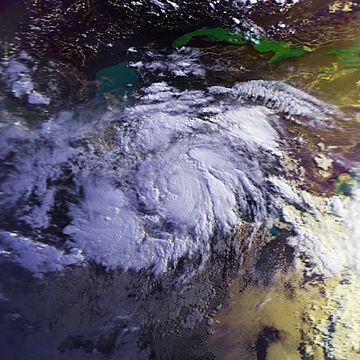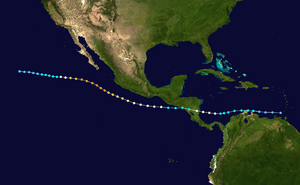Hurricane Cesar-Douglas facts for kids
| Category 4 major hurricane (SSHWS/NWS) | |

Hurricane Cesar before landfall
|
|
| Formed | July 24, 1996 |
|---|---|
| Dissipated | August 5, 1996 |
| Highest winds | 1-minute sustained: 130 mph (215 km/h) |
| Lowest pressure | 946 mbar (hPa); 27.94 inHg |
| Fatalities | 77 direct |
| Damage | $206 million (1996 USD) |
| Areas affected | Curaçao, Honduras, Nicaragua, Costa Rica, Colombia, Venezuela (as Cesar), southern Mexico (as Douglas) |
| Part of the 1996 Atlantic hurricane season 1996 Pacific hurricane season |
|
Hurricane Cesar-Douglas was a very strong storm that started in the Atlantic Ocean as Hurricane Cesar. It was a Category 1 hurricane in the Atlantic. This storm then moved across Central America and entered the Pacific Ocean, where it was renamed Hurricane Douglas. In the Pacific, it became a much stronger Category 4 hurricane. This made it the most powerful storm of the 1996 Pacific hurricane season.
Contents
How Hurricane Cesar-Douglas Formed and Traveled

The journey of this storm began with a tropical wave near Dakar, Senegal, in Africa. This wave traveled across the Atlantic Ocean. It didn't become a named storm until it was close to the Windward Islands. On July 24, 1996, it officially became Tropical Depression Three.
The next day, July 25, Tropical Depression Three grew stronger and was named Tropical Storm Cesar. Cesar didn't get much stronger at first because it was near land. However, as it moved into the southwestern Caribbean Sea, it started to gain more power.
By July 27, when it was about halfway between Nicaragua and South America, Tropical Storm Cesar became a full-fledged hurricane. Hurricane Cesar reached its strongest winds in the Atlantic on July 28, blowing at about 85 miles per hour. Later that same day, Hurricane Cesar made landfall near Bluefields, in Nicaragua, still at its peak strength.
After hitting land, Cesar weakened into a tropical storm as it moved over Central America. But it was strong enough to survive crossing the land.
Late on July 28, Cesar reached the Pacific Ocean. Here, it was given a new name: Tropical Storm Douglas. The very next day, Tropical Storm Douglas became a hurricane. Later, on August 1, Hurricane Douglas reached its highest wind speeds, which were an incredible 130 miles per hour. Douglas then started to get weaker because it moved over cooler waters. Finally, on August 5, Hurricane Douglas completely died out.
What Happened to the Names "Cesar" and "Douglas"?
Sometimes, if a hurricane causes a lot of damage or deaths, its name is "retired." This means the name will never be used again for another hurricane in that ocean basin. The name "Cesar" was retired because of the impact it had. This is why you won't see another Hurricane Cesar in the Atlantic. Instead, names like Cristobal were used in 2002 and 2008.
However, the name "Douglas" was not retired for the Pacific Ocean. This means that the name "Douglas" could be, and has been, used again for other storms in the Pacific, such as in the 2002 and 2008 hurricane seasons.
|
Tropical cyclones of the 1996 Atlantic hurricane season |
|||||||||||||||||||||||||||||
|
|
||||||||||||||||||||||||||||
|
|
|||||||||||||||||||||||||||||
|
Images for kids
-
Hurricane Cesar at its strongest off the coast of Nicaragua on July 28
See also
 In Spanish: Huracán Cesar-Douglas para niños
In Spanish: Huracán Cesar-Douglas para niños



